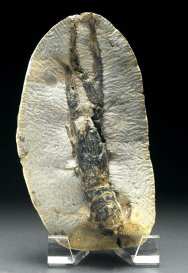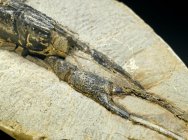|  Description:
This rare, museum grade lobster fossil is superbly preserved in
three dimensions The arms and claws are fully extended, and both
eye-stalks are preserved. Note the pustulate carapace and well preserved
exoskeleton. The tail is tucked under and the legs are not exposed.
The concretion was shattered into six pieces when split. With expert
curation the lobster has been exposed and repaired; now lying comfortably,
as if on a oval serving platter. Description:
This rare, museum grade lobster fossil is superbly preserved in
three dimensions The arms and claws are fully extended, and both
eye-stalks are preserved. Note the pustulate carapace and well preserved
exoskeleton. The tail is tucked under and the legs are not exposed.
The concretion was shattered into six pieces when split. With expert
curation the lobster has been exposed and repaired; now lying comfortably,
as if on a oval serving platter.
Only
a few of these specimens have been preserved in this state of preservation.
This species is found in the same areas as the more famous and numerous
iridescent ammolite ammonites, Placenticeras. Those rare lobsters
discovered normally shatter when the concretion is broken, or are
in a poor state of preservation. According to the previous owner,
this one was obtained from a small collection, and the others went
to a university for study.
"The
lobsters are preserved in argillaceous limestone concretions that
have the shape of slightly flattened prolate ellipsoids. The concretions
that contain lobsters generally contain only a single animal. However,
a few contain two lobsters, and one was discovered that contained
a lobster and a crab. The lobsters are preserved as sediment filled
exoskeletons which usually have the claws, cephalothorax and abdomen
articulated, and are preserved in an upright position stretched
out along the axis of the animal. The abdomen may be enrolled to
varying degrees. Most specimens show some evidence of minor dorsal-ventral
compression and a few are laterally compressed. Diagenetic changes
have altered the chitinous exoskeletons although preservation is
delicate enough to have preserved internal (endophragmal) skeletons
in some individuals. The lobster corpses and molts decayed on the
sea bottom and as the articulating membranes decomposed the surrounding
sediment found its way into the interior of the exoskeleton. Calcite
precipitated and filled the interstitial spaces in the mud in and
around the lobsters forming the argillaceous limestone concretions."
(From the Journal of Paleontology, November 1977, Robert
F. Feldman).
|


